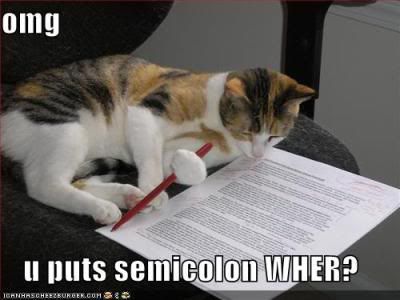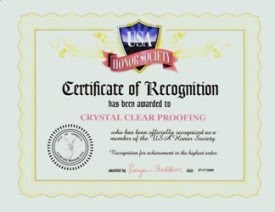
As "Sentence Splicers"
Semicolons separate things. Most commonly, they separate two main clauses that are closely related to each other but could stand on their own as sentences if you wanted them to. Semicolons are sometimes thought of as sentence splicers: they splice sentences together.
It was below zero; Jenny wondered if she would freeze to death.
It was below zero. Jenny wondered if she would freeze to death.
One reason you may choose to use a semicolon instead of a period is if you wanted to add variety to your sentence structure; for example, if you thought you had too many short, choppy sentences in a row, you could add variety by using a semicolon to string together two main clauses into one longer sentence. But, when you use a semicolon, the main clauses should be closely related to each other. You wouldn't write, "It was below zero; Jenny had pizza for dinner," because those two main clauses have nothing to do with each other. In fact, the other reason to use a semicolon instead of a period is to draw attention to the relationship between two clauses.
With Coordinating Conjunctions
An important thing to remember is that (with one exception) you never use semicolons with coordinating conjunctions such as and, or, and but when you're joining when you're joining two main clauses. If you're joining two main clauses with a coordinating conjunction, use a comma: It was below zero, and Jenny wondered if she would freeze to death.
The one exception is when you are writing a list of items and need to separate items within the list.
This week's winners are Stanley in Des Moines, Iowa; Joe in Irvine, California; and Ruth in Seattle, Washington.
Because each item in the list requires a comma to separate the city from the state, you have to use a semicolon to separate the items themselves.
With Conjunctive Adverbs
Finally, you use a semicolon when you use a conjunctive adverb to join two main clauses. Some of the more common conjunctive adverbs include: accordingly, again, also, anyway, besides, certainly, consequently, finally, furthermore, hence, incidentally, indeed, instead, likewise, meanwhile, moreover, namely, nevertheless, next, nonetheless, otherwise, similarly, specifically, still, subsequently, then, therefore, thus.
Conjunctive adverbs typically show some kind of relationship between the two main clauses.
Jenny is on vacation; therefore, Stan has to do extra work on the project.
Stan didn't mind doing the extra work; however, he would like to be thanked.
Sometimes people find it hard to remember to use commas with coordinating conjunctions and semicolons with conjunctive adverbs, so a tip to help you know when to use which, is to remember that commas are smaller than semicolons and go with coordinating conjunctions, which are almost always short two- or three-letter words–small punctuation mark, small words. Semicolons are bigger and they go with conjunctive adverbs, which are almost always longer than three letters–bigger punctuation, bigger words.
Source: Grammar Girl


































































Another great and much needed post by people like me. This is why you are the Grammar Goddess!
ReplyDeleteBTW, I love the new look of your sidebar.
Oh I agree. You are the Grammar Goddess. I have the worst time with commas and semicolons. Thanks for the helpful post. I'll have to print this out and keep it close.
ReplyDeleteLove the photo!
ReplyDeleteThe last area is where I still trip up...
Oh great Grammar Goddess, how I worship you! Thanks so much for this post.
ReplyDeleteElspeth
You make it look so easy!
ReplyDeleteGood one!
ReplyDeleteOh my goodness you have made it so clear! I'm sure it will be this clear when I am writing later...Thank you!
ReplyDeleteMichele
SouthernCityMysteries